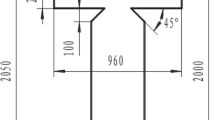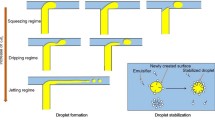Abstract
This article investigates the formation of albumin droplets in fatty esters by means of a flow focussing geometry where the continuous oil phase is introduced in the two lateral branches of a Y junction. The effect of the geometry is investigated in order to clarify the scales controlling the droplet generation with this type of fluid couple. The transition from regular droplet flow to stratified flow is identified from the experiments. It is found that the droplet size varies linearly with the flow rate ratio between the disperse and continuous phases. This is similar to what is found in T junctions microfluidic systems for low capillary numbers.










Similar content being viewed by others
References
Adzima B, Velankar S (2006) Pressure drop for droplet flows in microfluidic channels. J Micromech Microeng 16:1504–1510
Anna S, Bontoux N, Stone HA (2003) Formation of dispersions using “flow focusing” in microchannels. Appl Phys Lett 82:364–366
Bouchemal K, Briancon S, Perrier E, Fessi H (2004) Nano-emulsion formulation using spontaneous emulsification: solvent, oil and surfactant optimisation. Int J Pharm 280:241–251
Boxshall K, Wu M-H, Cui Z, Cui Z, Watts JF, Baker MA (2006) Simple surface treatments to modify protein adsorption and cell attachment properties within a poly(dimethylsiloxane) micro-bioreactor. Surf Interface Anal 38:198–201
Chen P, Lahooti S, Policova Z, Cabrerizo-Vilchez MA, Neumann AW (1996) Concentration dependance of the film pressure of human serum albumin at the water/decane interface. Colloids Surf B 6:279–289
Christopher GF, Anna SL (2007) Microfluidic methods for generating continuous droplet streams. J Phys D 40:R319–R336
Garstecki P, Fuerstman MJ, Stone H, Whitesides G (2006) Formation of droplets and bubbles in a microfluidic t-junction-scaling and mechanism of break up. Lab on a Chip 6:437–446
Geerken M, Groenendijk M, Lammertink R, Wessling M (2008) Micro-fabricated metal nozzle plates used for water-in-oil and oil-in-water emulsification. J Membr Sci 310:374–383
Guillot P, Colin A, Utada AS, Ajdari A (2007) Stability of a jet in confined pressure-driven biphasic flows at low Reynolds number. Phys Rev Lett 99:104502–104504
Humphry KJ, Ajdari A, Fernandez-Nieves A, Stone HA, Weitz DA (2009) Suppression of instabilities in multiphase flow by geometric confinement. Phys Rev E 79:056310
Hurteaux R, Edwards-Levy F, Laurent-Maquin D, Levy MC (2005) Coating alginate microspheres with a serum albumin-alginate membrane: application to the encapsulation of a peptide. Eur J Pharm Sci 24:187–197
Husny J, Cooper White J (2006) The effect of elasticity on drop creation in t-shaped microchannels. J Non-Newtonian Fluid Mech 137:121–136
Kogan A, Garti N (2006) Microemulsions as transdermal drug delivery vehicles. Adv Colloid Interface Sci 123-126:369–385
Lee W, Walker LM, Anna SL (2009) Role of geometry and fluid properties in droplet and thread formation processes in planar flow focussing. Phys Fluids 21:032103
Li S, Xu J, Wang Y, Luo G (2008) Controllable preparation of nanoparticles by drops and plugs flow in a microchannel device. Langmuir 24:4194–4199
Mc Clement DJ, Decker EA, Weiss J (2007) Emulsion-based delivery systems for lipophilic bioactive components. J Food Sci 72:R109–R124
McDonald JC, Whitesides GM (2002) Poly(dimethylsiloxane) as a material for fabricating microfluidic devices. Acc Chem Res 35:491–499
Steegmans MLJ, Schroen CGPH, Boom RM (2009) Generalized insights in droplet formation at t-junctions through statistical analysis. Chem Eng Sc 64:3042–3050
Stone HA, Stroock AD, Ajdari A (2004) Engineering flows in small devices: Microfluidics towards a lab-on-a-chip. Lab on a Chip 36:381–412
Stone HA (1994) Dynamics of drop deformation and breakup in viscous fluids. Ann Rev Fluid Mech 26:65–102
Stride E, Pancholi K, Edirisinghe M (2008) Dynamics of bubble formation in highly viscous liquids. Langmuir 24:4388–4393
Subramanian N, Ghospal S, Acharya A, Moulik S (2005) Formulation and physicochemical characterization of microemulsion system using isopropyl myristate, medium-chain glyceride, polysorbate 80 and water. Chem Pharm Bull 53:1530–1535
Tabeling P (2005) Introduction to microfluidics. Oxford University Press, Oxford
Thorsen T, Roberts RW, Arnold FH, Quake SR (2001) Dynamic pattern formation in a vesicle-generating microfluidic device. Phys Rev Lett 86:4163–4166
van der Graaf S, Nisisako T, Schroen CGPH, van der Sman RGM, Boom RM (2006) Lattice boltzmann simulation of droplet formaation in a t-shpaed microchannel. Langmuir 22:4144–4152
Xu JH, Luo GS, Li SW, Chen GG (2006) Shear force induce monodisperse droplet formation in a microfluidic device by controlling wetting properties. Lab on a Chip 6:131
Acknowledgments
This work was supported by the Conseil Régional de Picardie (France) project μFIEC. Pei Yuan He’s PhD grant was funded by the China Scholarship Council. The microchip moulds were manufactured by Dr. Laurent Griscom (UMR CNRS 8089 ENS Cachan, France). The authors would like to acknowledge the collaboration of Professor F. Edwards-Lévy (UMR CNRS 6229, Université de Reims Champagne Ardenne, France) who suggested the use of fatty ester and HSA solution as a fluid system of interest for pharmaceutical applications.
Author information
Authors and Affiliations
Corresponding authors
Rights and permissions
About this article
Cite this article
He, P., Barthès-Biesel, D. & Leclerc, E. Flow of two immiscible liquids with low viscosity in Y shaped microfluidic systems: effect of geometry. Microfluid Nanofluid 9, 293–301 (2010). https://doi.org/10.1007/s10404-009-0546-y
Received:
Accepted:
Published:
Issue Date:
DOI: https://doi.org/10.1007/s10404-009-0546-y




